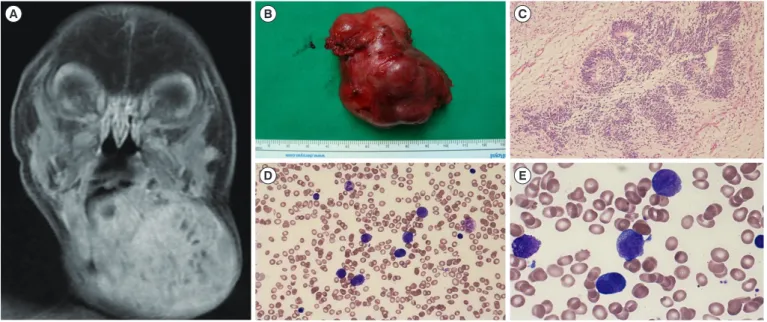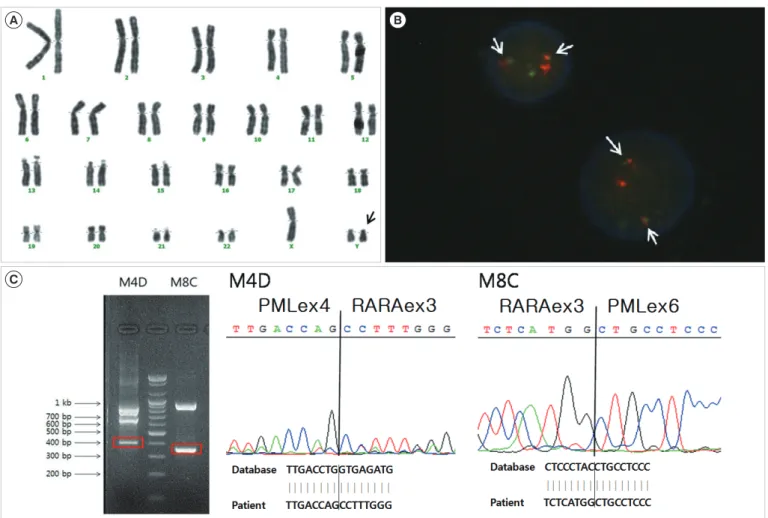ISSN 2234-3806 • eISSN 2234-3814
544 www.annlabmed.org http://dx.doi.org/10.3343/alm.2015.35.5.544 Ann Lab Med 2015;35:544-547
http://dx.doi.org/10.3343/alm.2015.35.5.544
Letter to the Editor
Diagnostic Hematology
Immature Teratoma and Subsequent Acute
Promyelocytic Leukemia in a Pediatric Patient With XYY Syndrome
Ju-Heon Park, M.D.1,*, Hyun-Woo Choi, M.D.1,*, Bo-Young Seo, M.D.1, Min-Goo Kang, M.D.1,4, Soo-Hyun Kim, M.D.1, Hee-Jo Baek, M.D.2,3, Hoon Kook, M.D.2,3, and Myung-Geun Shin, M.D.1,3,4
Departments of Laboratory Medicine1 and Pediatrics2, Environmental Health Center for Childhood Leukemia and Cancer3, Chonnam National University Hwasun Hospital, Hwasun-gun, Jeollanam-do; Brain Korea 21 Plus Project4, Chonnam National University Medical School, Gwangju, Korea
XYY syndrome is a rare sex chromosome abnormality that oc- curs in 1 of 1,000 male births, and shows a normal phenotype with the exception of increased stature [1]. However, other clini- cal characteristics such as psychological dysfunction [2] and urinary tract and hepatobiliary system abnormalities have been reported with XYY syndrome [3]. Here, we describe the first case of XYY syndrome with the occurrence of a cervical imma- ture teratoma and subsequent acute promyelocytic leukemia (APL).
The patient was born as a full-term baby and had an irregu- lar-shaped mass measuring 10 cm, on the left side of his neck.
Magnetic resonance imaging showed a well-defined, enhanced mass, measuring 5.6×4.9×4.5 cm in size (Fig. 1A). Alpha-fe- toprotein (AFP) in the blood was markedly above the normal ranges (30,066.0 IU/mL). Conventional cytogenetics of periph- eral blood revealed a 47,XYY karyotype, indicating an extra Y chromosome. Pathological diagnosis of the excised mass con- firmed an immature teratoma, grade 3 (Fig. 1B and C). The pa- tient was treated with three cycles of cisplatin (10 mg/m2 for 5 days) and etoposide (50 mg/m2 for 5 days) after surgical resec-
tion. The serum AFP level after the first cycle of chemotherapy was 289.3 IU/mL, and the level was normalized after four months of age.
Twenty-eight months after completion of chemotherapy, the patient showed multiple bruises on his extremities and bicyto- penia (white blood cells: 6.3×109/L, hemoglobin: 8.4 g/dL, and platelets: 18×109/L). Bone marrow (BM) aspiration showed that 43% of the promyelocytes were abnormal (Fig. 1D and E). Flow cytometric analysis of BM cells revealed a clonal myeloid cell population that was positive for CD13 (60.4%), CD33 (58.7%), and MPO (96.4%), and negative for CD34 (4.1%) and HLA-DR (1.9%).
Conventional cytogenetics of BM cells revealed a 47,XYY karyotype without abnormalities in chromosomes 15 and 17 (Fig. 2A). However, a PML/RARA rearrangement was detected by FISH (Fig. 2B), multiplex reverse-transcription PCR (RT-PCR) (HemaVision kit; DNA-Diagnostic, Risskov, Denmark), and quantitative real-time PCR (qRT-PCR). We confirmed PML/
RARA rearrangement by direct sequencing (Fig. 2C).
The patient was treated with ATRA, and after the first induc-
Received: January 7, 2015 Revision received: March 18, 2015 Accepted: June 12, 2015
Corresponding author: Myung-Geun Shin
Department of Laboratory Medicine, Chonnam National University Medical School and Chonnam National University Hwasun Hospital, 160 Ilsimri, Hwasun-eup, Hwasun-gun, Jeollanam-do 519-890, Korea
Tel: +82-61-379-7950, Fax: +82-61-379-7984 E-mail: mgshin@chonnam.ac.kr
*These two authors equally contributed to this work.
© The Korean Society for Laboratory Medicine.
This is an Open Access article distributed under the terms of the Creative Commons Attribution Non-Commercial License (http://creativecommons.org/licenses/by-nc/3.0) which permits unrestricted non-commercial use, distribution, and reproduction in any medium, provided the original work is properly cited.
Park J-H, et al.
Teratoma and APL in XYY syndrome
http://dx.doi.org/10.3343/alm.2015.35.5.544 www.annlabmed.org 545
tion chemotherapy, morphological remission was achieved with a decrease in PML-RARA/ABL, as determined by qRT-PCR. Af- ter two cycles of consolidation chemotherapy, the patient began maintenance chemotherapy.
According to recent reports, the incidence of cancer in the XYY syndrome population is not significantly different from that in the general population; however, mortality from cancer is sig- nificantly higher [1, 4].
Hematologic malignancies are the most commonly reported neoplasms associated with XYY syndrome, and other neoplasms are reported rarely [5]. In this case, APL occurred 28 months after chemotherapy for the teratoma. Therapy-related AML oc- curs with a latency period of one to five years after treatment with topoisomerase II inhibitors and other chemotherapeutics. It is often associated with balanced chromosomal translocations, and characteristics and outcomes are not very different from those of de novo AML [9]. Etoposide-related AML occurs mostly in patients treated with a high cumulative dose (>2,000 mg/m2) [7]. In this patient, because of etoposide use, the 28-month in- terval, and the PML-RARA rearrangement, therapy-related APL was suspected. However, the cumulative dose of etoposide was much lower than 2,000 mg/m2. Therefore, we also considered other possibilities such as malignant transformation of the tera- toma to leukemia [8] or the genetic vulnerability of hematopoi-
etic tissue itself to chemotherapy in XYY syndrome cases. Leu- kemia associated with a teratoma is reported to occur simulta- neously or within a short interval of about six months (range, 1-22 months) [9]. It is presumed that hematopoietic microfoci within the primary teratoma tissue might be the origin of the leu- kemia; this hypothesis is supported by identical clonal aberra- tions in both teratoma and leukemia [9]. A more likely explana- tion for pathogenesis is an association with the effects of XYY syndrome itself. First, dysfunction or malformation of the kid- neys and liver are common abnormalities in patients with XYY syndrome, making them more susceptible to cytotoxic compli- cations of chemotherapy [10]. Second, constitutional aberra- tions might result in a high susceptibility to potentially leukemia- inducing agents. Considering these possibilities, careful admin- istration of chemotherapy dose and attentive follow-up examina- tions are recommended when treating neonates with XYY syn- drome.
In summary, although further evaluations in large-scale epi- demiological studies will be required to demonstrate the associ- ation between XYY syndrome, teratoma, and subsequent leuke- mia, our case showed a new phenotype, the presentation of ter- atoma and APL, in the spectrum of disease in pediatric XYY syndrome.
Fig. 1. Radiographical and morphological findings of teratoma and bone marrow study. (A) A coronal magnetic resonance image (MRI) at birth showed a unilateral, large, well-defined, and enhanced mass. (B) A well-circumscribed and irregular-shaped mass was extirpated from left side of the neck (7 cm×5 cm). (C) The tissue biopsy showed an immature teratoma with primitive neuroepithelial rosettes lined by basophilic cells (hematoxylin and eosin stain, ×100). (D) Bone marrow findings at diagnosis showed depleted trilineage cellular compo- nent, proliferation of abnormal promyelocytes with large purple granules and irregular-shaped (kidney-shaped or bilobed) nuclei (Wright- Giemsa stain, ×400). (E) High magnification images from (D) disclosed abnormal promyelocytes (Wright-Giemsa stain, ×1,000).
A B
D
C
E
Park J-H, et al.
Teratoma and APL in XYY syndrome
546 www.annlabmed.org http://dx.doi.org/10.3343/alm.2015.35.5.544
Authors’ Disclosures of Potential Conflicts of Interest
No potential conflicts of interest relevant to this article were re- ported.
Acknowledgments
This study was supported by grants from the National Research Foundation of Korea (NRF) (No. 2011-0015304), and the Lead- ing Foreign Research Institute Recruitment Program (No. 2011- 0030034) through the NRF funded by the Ministry of Educa- tion, Science and Technology (MEST), and a grant from the Na- tional R&D Program for Cancer Control, Ministry of Health &
Welfare, Republic of Korea (No. 2013-1320070). We thank
Fig. 2. Cytogenetic and molecular studies at diagnosis of acute promyelocytic leukemia. (A) Giemsa-banded karyotype of bone marrow showing 47,XYY chromosomal arrangement. Additional Y (in arrow) and intact chromosomes 15 and 17 are observed. (B) Dual-color FISH with PML-RARA probes demonstrates the presence of PML-RARA fusion (in arrows). (C) Direct sequencing for the confirmation of PML- RARA rearrangement shows that the 396-bp band of M4D contains a fusion transcript of PML exon 4-RARA exon 3 and that the 353-bp band of M8C contains a fusion transcript of PML exon 6-RARA exon 3. The fusion transcript of PML exon 4-RARA exon 3 is a result of al- ternative splicing of the PML exon 6-RARA exon 3 fusion gene.
A
C
B
Seung Yeob Lee who provided advice during the drafting of the manuscript, and Sung-Du Jeong and Jae-Sung Lee who pro- vided technical support for molecular genetic studies.
REFERENCES
1. Stochholm K, Juul S, Gravholt CH. Diagnosis and mortality in 47,XYY persons: a registry study. Orphanet J Rare Dis 2010;5:15.
2. Jacobs PA, Brunton M, Melville MM, Brittain RP, McClemont WF. Ag- gressive behavior, mental sub-normality and the XYY male. Nature 1965;208:1351-2.
3. Côté GB, Tsomi K, Papadakou-Lagoyanni S, Petmezaki S. Oligohydram- nios syndrome and XYY karyotype. Ann Genet 1978;21:226-8.
4. Higgins CD, Swerdlow AJ, Schoemaker MJ, Wright AF, Jacobs PA; UK Clinical Cytogenetics Group. Mortality and cancer incidence in males with Y polysomy in Britain: a cohort study. Hum Genet 2007;121:691-6.
5. Limacher JM, Girard-Lemaire F, Jeandidier E, Chenard-Neu MP, Kas- sem M, Flori E, et al. Gastrointestinal stromal tumor in an XYY/XY male.
Park J-H, et al.
Teratoma and APL in XYY syndrome
http://dx.doi.org/10.3343/alm.2015.35.5.544 www.annlabmed.org 547
Cancer Genet Cytogenet 2002;133:152-5.
6. Swerdlow SH, Campo E, et al. eds. WHO Classification of tumours of haematopoietic and lymphoid tissues. 4th ed. Lyon: International Agen- cy for Research on Cancer, 2008:127-9.
7. Schneider DT, Hilgenfeld E, Schwabe D, Behnisch W, Zoubek A, Wes- salowski R, et al. Acute myelogenous leukemia after treatment for ma- lignant germ cell tumors in children. J Clin Oncol 1999;17:3226-33.
8. Harms D, Zahn S, Göbel U, Schneider DT. Pathology and molecular bi- ology of teratomas in childhood and adolescence. Klin Padiatr 2006;
218:296-302.
9. Nichols CR, Roth BJ, Heerema N, Griep J, Tricot G. Hematologic neo- plasia associated with primary mediastinal germ-cell tumors. N Engl J Med 1990;322:1425-9.
10. Shibata S, Kami M, Kishi Y, Hamaki T, Ueyama JI, Miyakoshi S, et al.
Severe regimen-related toxicity occurring in a patient with XYY syn- drome receiving allogeneic peripheral blood stem cell transplantation.
Ann Hematol 2002;81:407-9.

